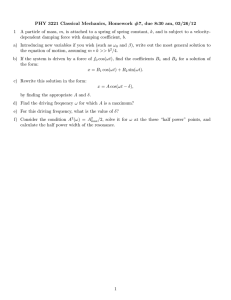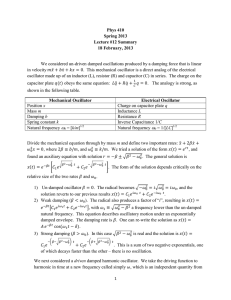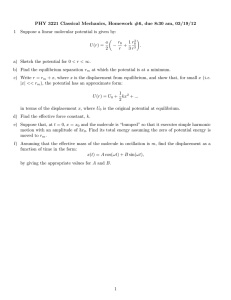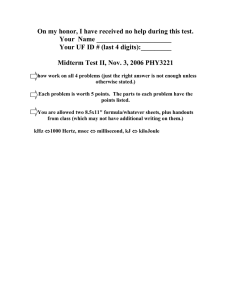11 Lecture 10-19 11.1 Chapter 5 Oscillations (con)
advertisement
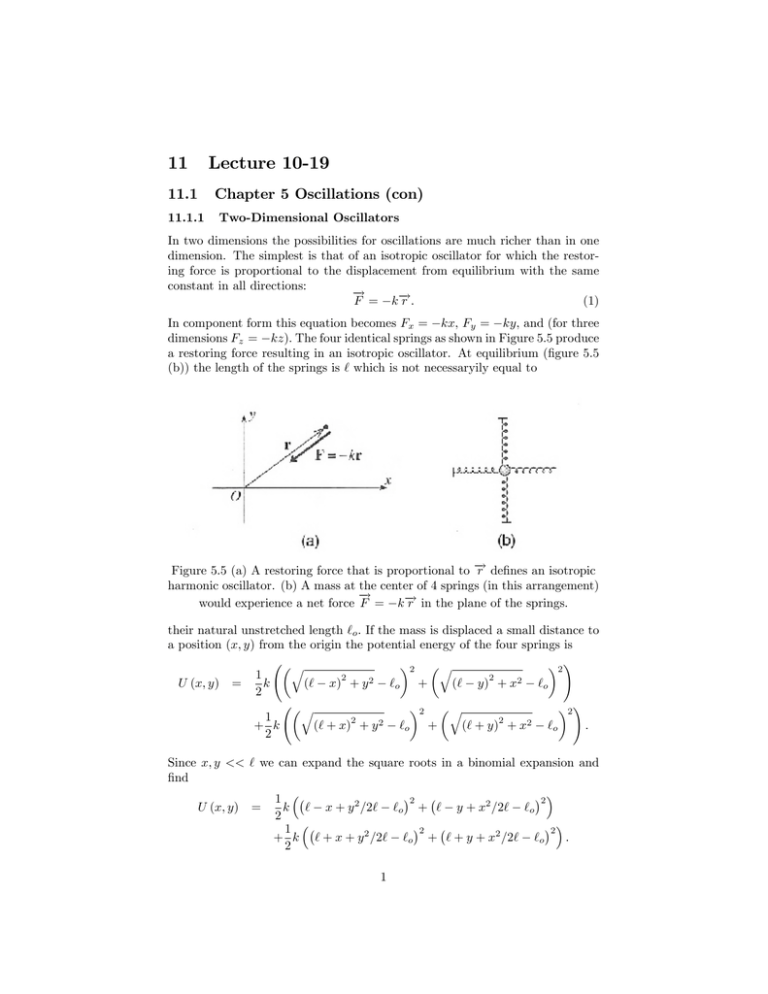
11 Lecture 10-19 11.1 11.1.1 Chapter 5 Oscillations (con) Two-Dimensional Oscillators In two dimensions the possibilities for oscillations are much richer than in one dimension. The simplest is that of an isotropic oscillator for which the restoring force is proportional to the displacement from equilibrium with the same constant in all directions: ! F = k! r: (1) In component form this equation becomes Fx = kx; Fy = ky; and (for three dimensions Fz = kz): The four identical springs as shown in Figure 5.5 produce a restoring force resulting in an isotropic oscillator. At equilibrium (…gure 5.5 (b)) the length of the springs is ` which is not necessaryily equal to Figure 5.5 (a) A restoring force that is proportional to ! r de…nes an isotropic harmonic oscillator. (b) A mass at the center of 4 springs (in this arrangement) ! would experience a net force F = k ! r in the plane of the springs. their natural unstretched length `o : If the mass is displaced a small distance to a position (x; y) from the origin the potential energy of the four springs is ! q q 2 2 1 2 2 U (x; y) = k (` x) + y 2 `o + (` y) + x2 `o 2 ! q q 2 2 1 2 2 2 2 + k (` + x) + y `o + (` + y) + x `o : 2 Since x; y << ` we can expand the square roots in a binomial expansion and …nd U (x; y) = 1 2 2 k ` x + y 2 =2` `o + ` y + x2 =2` `o 2 1 2 + k ` + x + y 2 =2` `o + ` + y + x2 =2` `o 2 1 2 : Expanding and summing these terms while ignoring terms of order x4 =`2 and y 4 =`2 the potential energy for the system becomes x2 + y 2 (1 U (x; y) = 2k U (r) = 1 kef f r2 + Uo ; where kef f = 2k (2` 2 `o =2`) + (` 2 `o ) `o ) =`: Note that this combination of springs produces a stable equilibrium as long as 2` `o > 0: A particle that is subject to this kind of force in two dimensions satis…es the two independent equations x= ! 2 x and y = ! 2 y; (2) where as usual ! 2 = k=m. The solutions for these two equations were discussed in the last section and are x (t) = Ax cos (!t y (t) = Ay cos (!t x) ; y) ; (3a) (3b) where the four constants are determined by the initial conditions of the problem. By rede…ning the time origin we can eliminate one of the phases. Thus the simplest form for the general solution is x (t) = Ax cos !t; y (t) = Ay cos (!t ); (4a) (4b) where = y x and is the relative phase of the x and y oscillations. The behavior of the solutions 4a and 4b depends on the values of the three constants, Ax ; Ay ; and : If either Ax or Ay is zero, then the particle executes simple harmonic motion along one of the axes. If neither Ax nor Ay is zero, the motion depends critically on the relative phase : If = 0; then both x and y rise and fall in step along a line passing through the origin with slope Ay =Ax as shown in Figure 5.6(a). If = =2; then x and y oscillate out of step. When x is at an extreme, y is zero and vice versa. The resulting curve is an ellipse with semimajor and semiminor axes Ax and Ay as shown in Figure 5.6(b). For other values of the curves determined by y (t) and x (t) are slanting ellipses as shown in Figure 5.6(c) for = =4: What would you expect for = ? 2 Figure 5.6 Motion of a two-dimensional isotropic oscillator as given by equations 5.38 (a) & (b) for relative phases (a) = 0; (b) = =2; and (c) = =4: In an anisotropic oscillator, the restoring force constants are di¤erent for the di¤erent directions: Fx = kx x; Fy = ky y; and Fz = kz: (5) For simplicity we will again only consider this problem in two dimensions. The solutions to Newton’s EOM are similar to the isotropic case and we have x (t) = Ax cos ! x t; y (t) = Ax cos (! y t ): (6a) (6b) Because of the two di¤erent frequencies, there is a much richer variety of possible motions. If ! x =! y is a rational number, it is fairly easy to see (as an exercise for the student) that the motion is periodic. The resulting path is a Lissajou …gure and an example for ! x =! y = 2 is shown in Figure 5.7(a). In that …gure you can see that x goes back and forth twice for each time that y does so once. If ! x =! y is an irrational number then the motion is p more complicated and never repeats itself. This case is illustrated for ! x =! y = 2 in …gure 5.7(b). Figure 5.7 p Possible paths for anisotropic oscillators with (a) ! x = 2! y and (b) ! x = 2! y : The motion in (b) is called quasi-periodic as it is periodic in either x or y but ! r (t) is not periodic. 11.1.2 Damped Oscillations We now return to the one dimensional oscillator, but this time with the possibility that there are resistive or drag e¤ects that will dampen these oscillations. Here we will assume that the resistive force is proportional to v, speci…cally, ! f = b! v : When the we studied the e¤ects of wind resistance, this form of the drag only applied for small Reynolds number (i.e. usually small velocities). However not only does this form lead to a linear di¤erential equation, it also appears in other contexts and therefore is well worth studying. 3 Consider then a mass on a spring in the presence of a linear resistance. Newton’s EOM then becomes d2 x dx m 2 +b + kx = 0: (7) dt dt One of the really nice things about physics is the way that the same mathematical equation can arise in totally di¤erent scenarios. Thus the understanding of the solutions to an equation in one arena carries over immediately to the other. Consider for a moment a series LRC circuit. The voltage across an inductor given by VL = Ldi=dt; a resistor VR = Ri; and a capacitor VC = q=C: Here i is the current in the circuit and is related to q the charge by i = dq=dt: Summing the voltages around a loop containing an inductor, resistor, and a capacitor leads to q dq d2 q = 0: (8) L 2 +R + dt dt C This has exactly the same form as equation (7) for a damped oscillator. This means that anything we learn from the solutions of the damped oscillator will apply immediately to an LRC circuit. Returning to the equation for the damped oscillator, we divide by the mass and de…ne = b=2m: We will keep the de…nition ! 2o = k=m: The equation describing a damped oscillator then becomes dx d2 x +2 + ! 2o x = 0 (9) 2 dt dt It is useful to notice that both and ! o have the units of inverse time or equivalently frequency. Equation (9) is another second order, linear, homogeneous di¤erential equation. Thus if we can …nd two independent solutions x1 (t) and x2 (t) ; then any solution must have the form x (t) = C1 x1 (t) + C2 x2 (t) : (10) As a trial solution we will consider the form x (t) = ert : (11) Substituting this trial solution into equation (9), we …nd that this form can only be a solution if (and only if) r2 + 2 r + ! 2o = 0; (12) which is sometimes called the auxillary equation. The solutions to this quadratic equation are q q 2 2 2 r1 = + ! o and r2 = ! 2o : (13) A general solution must then be x (t) = e t p C1 e 2 ! 2o t + C2 e p 2 ! 2o t : (14) This solution is too messy to be illuminating, but by examining it in various ranges of the damping constant we can begin to see what equation (14) entails. 4 Undamped Oscillation If there is no damping, i.e. reduces to x (t) = C1 ei!o t + C2 e i!o t ; = 0; then the solution (15) which are (at least by now) the familiar solutions for the undamped oscillator. Weak Damping We now consider the limit !o > ; (16) a condition often called underdamping. In this case the square root term is imaginary which allows us to write q 2 < !o : (17) ! 1 = ! 2o Here ! 1 is a frequency, less than the natural frequency ! o : In the case of very weak damping ! o >> ; ! 1 is very close to ! o : The solution can be written as x (t) = e t C1 ei!1 t + C2 e i! 1 t : (18) This solution is a product of two factors. The …rst is an exponential decay. The second term which is inside the brackets is exactly the form of a simple harmonic oscillator. From our brief study of that system we can write the solution as x (t) = Ae t cos (! 1 t ): (19) This solution is that of a simple harmonic oscillator with a frequency of ! 1 with an exponentially decaying amplitude and is shown in …gure 5.8. Figure 5.8 Underdamped oscillations are simple harmonic oscillations with an exponentially decaying amplitude. Thus, for underdamped oscillations, can be thought of as a decay parameter, a measure of the rate at which the oscillations die out. The larger the more rapidly the more rapid the decay, at least as we shall see for the case < ! o : 5 Strong Damping Now we will consider the case when > !o ; (20) a condition often referred to as overdamping. In this case the term inside the square root is positive so that the exponents are all real. The solution is now p 2 2 p 2 2 !o t !o t + x (t) = C1 e + C2 e : (21) Here we have two exponential solutions but of which decrease in time. The system is so damped that there are no oscillations. The …rst term on the right in equation (21) decays more slowly than the second term. Hence in the overdamped case, the long term behavior of the motion is determined by the exponent in the …rst term, q 2 ! 2o : (22) decay parameter = In fact, careful inspection of equation (22) shows that - contrary to what one might expect - the rate of decay of overdamped motion gets smaller as the damping constant increases. Figure 5.9 shows an example of the motion when the mass is given a kick from the origin at t = 0. Initially it moves out to a maximum displacement and then decays slowly back, returning to the origin as t ! 1. Figure 5.9 An example of overdamped motion in which the oscillator starts out with a velocity v = vo and decays back toward the origin. Critical Damping The boundary between underdamping and overdamping is called critical damping. This occurs when the damping constant is equal to the natural frequency, = !o : (23) This case has some interesting features, especially from a mathematical point of view. When = ! o the two solutions we found in equation (14) reduces to the same solution, namely x (t) = e t : (24) 6 Since there must be two independent solutions, we need to …nd another solution by other means. Fortunately, it is not hard. As you can easily check, the function x (t) = te t (25) is also a solution to the EOM. Thus the general solution is t x (t) = C1 e t + C2 te : (26) Since both terms contain the same exponential decay factor, e t , they decay at about the same rate with a decay parameter = ! o . It is interesting to compare the decay rates, i.e. the decay parameter, for the various types of damped oscillations. What we have learned is summarized in the table below damping none under critical =0 < !o = !o over > !o decay parameter 0 q 2 ! 2o Figure 5.10 is a plot of the decay parameter as a function of and it clearly shows the motion dies out most quickly when = ! o ; i.e. for critical damping. There are many situations where one wants any oscillations to die out as quickly as possible. For example when one wants the needle of an analog meter to settle down as quickly as possible for accurate readings. Similarly when you are driving a car over a bumpy road, you want the oscillations to die out quickly. In many cases the best results are when the damping is close (or equal to) the critical value. Figure 5.10 The decay parameter for damped oscillations as a function of the decay parameter : The motion dies out the most quickly for critical damping, = !o : 7 11.1.3 Driven Damped Oscillations Any natural oscillation has some damping (no matter how small) and will eventually come to rest. Thus for the oscillations to continue they must be subject to some external driving force. For example a child on a swing must have someone to push the swing. In this section we will consider the e¤ects of an external driving force F (t). From Newton’s EOM we have m d2 x = dt2 kx b dx + F (t) ; dt (27) which is usually written in the form m dx d2 x +b + kx = F (t) : dt2 dt (28) Just as with the case for the homogeneous equation, there is an analogy with this equation in electricity and magnetism. For an oscillating current to persist in an LRC circuit it is necessary to apply a driving EMF, E (t) : The equation for an LRC circuit then becomes L d2 q dq + R + Cq = E (t) ; 2 dt dt (29) which is a perfect analogy to equation (28). As in the undriven case, we divide equation (28) by m; replace b=m by 2 ; and k=m by ! 2o . With this notation equation (28) becomes dx d2 x +2 + ! 2o x = f (t) : dt2 dt (30) Linear Di¤erential Operators Before we discuss how to solve this equation, we need to streamline the notation. We can de…ne the di¤erential operator D as d d2 D = 2 +2 + ! 2o : (31) dt dt The meaning of this de…nition is that when D acts on x it results in Dx = d2 x dx +2 + ! 2o x: dt2 dt (32) With this convenient de…nition equation (30) is simply expressed as Dx = f (t) : (33) However the notion of an operator like that in equation (31) proves to be a powerful mathematical tool with many applications in physics. For our situation the important thing is that D as we de…ned it is a linear operator in that D (ax) = aDx and D (x1 + x2 ) = Dx1 + Dx2 : 8 (34) Combining these two properties yields D (ax1 + bx2 ) = aDx1 + bDx2 ; (35) where a and b are constants and x1 and x2 are arbitrary functions. Any operator that satis…es this equation is a linear operator. Without explicitly stating the fact, we used this property of linearity in our study of undriven oscillators. For that case f (t) = 0 and we had Dx = 0: (36) The superposition asserts that if x1 and x2 are solutions to this equation then so is ax1 + ax2 for any constants a and b. In this operator notation the proof is this is very simple. Given that Dx1 = 0 and Dx2 = 0 we see immediately that D (ax1 + bx2 ) = aDx1 + bDx2 = 0 + 0 = 0; (37) so that ax1 + bx2 is also a solution. Equation (36), Dx = 0; for the undriven oscillator is called a homogeneous equation, since every term involves x or derivatives of x exactly once. Equation (33), Dx = f (t) ; is called an inhomogeneous equation since it contains the inhomogeneous term f which does not involve x. We will now discuss the solution to inhomogeneous equations. Particular Solutions, Homogeneous Solutions, and Green’s Functions If we had a function xp (t) that satis…ed the inhomogeneous equation Dxp = f; (38) we would call this function xp (t) a particular solution of the equation. Next let us suppose that we also had a solution to the homogeneous equation Dxh = 0: (39) We call this function xh (t) a homogeneous solution to the equation. With these simple de…nitions we can prove a crucial result. First, if xp is a particular solution satisfying equation (33) then xp + xh is another solution, for D (xp + xh ) = Dxp + Dxh = f + 0 = f: (40) Given one particular solution xp gives us a large number of other solutions xp + xh : In fact we have found all the solutions. Since the function xh contains two arbitrary constants, and we know that the general solution of any second order di¤erential equation contains exactly two arbitrary constants we know that xp + xh is the general solution. This result means that all we have to do is somehow …nd a single particular solution xp (t) of the equation of motion, equation (33), and we have every solution in the form x (t) = xp (t) + xh (t) : 9 With these de…nitions, consider the case where we have a solution to the equation DG (t; t0 ) = (t t0 ) : (41) Here G (t; t0 ) is called the Green’s function for the operator D; and (t t0 ) is the Dirac delta function. The Dirac delta function has the property that it vanishes for all values of its argument whenever t 6= t0 : However it is in…nite when t = t0 in such a manner that it satis…es the normalization condition Z 1 (t t0 ) dt0 = 1: (42) 1 Since the Dirac delta function is zero everywhere except for when t = t0 we could reduce the limits on this normalization integral to Z t+ (t t0 ) dt0 = 1; (43) t where is vanishingly small as again the delta function only contributes when t = t0 . With this simple de…nition of a Dirac delta function, we note that this Green’s function is simply a particular solution for a very speci…c forcing function, namely (t t0 ) : As with any particular solution, we can add the solutions to the homogeneous equation to the Green’s function it remains a Green’s function for the operator D. One of the advantages (the one that is of interest to us here) is that having a Green’s function for any linear operator D allows to obtain the particular solution for an arbitrary forcing function. Consider the integral Z 1 u (t) = G (t; t0 ) f (t0 ) dt0 : (44) 1 If we operate on the function u (t) that results from this integral we …nd Z 1 Z 1 0 0 0 Du (t) = D G (t; t ) f (t ) dt = DG (t; t0 ) f (t0 ) dt0 : (45) 1 1 This last step comes from the fact that D is a linear operator that is operating on the t coordinate. Since the integral over t0 is basically a linear sum we are free to bring D inside the integration. Once inside the integral it operates on the Green’s function and we …nd Z 1 Z t+ Du (t) = (t t0 ) f (t0 ) dt0 = (t t0 ) f (t0 ) dt0 ; (46a) 1 Du (t) = f (t) Z t t+ (t t0 ) dt0 = f (t) : (46b) t Since the delta function vanishes for all values of t0 except when t0 = t; the only value of f (t0 ) that contributes to the integration is when t = t0 : This 10 combined with the normalization of the delta function results in the identity that we obtained in the above development Z 1 f (t) = (t t0 ) f (t0 ) dt0 : (47) 1 We see from equation (38) that the function u (t) that we obtained in equation (46b) is a particular solution. This is a very important result, for it tells us that if we have the Green’s function for the linear operator D, then all we have to do to obtain a particular solution for an arbitrary forcing function is perform the integral in equation (44). We should note however that as with any particular solution we can always add a homogeneous solution to the Green’s function and it remains a Green’s function. This is very valuable for this is often necessary to obtain a Green’s function which satis…es the boundary conditions of a given problem. This is accomplished by adding the appropriate homogeneous solutions to the Green’s function. We shall not pursue this approach any further for obtaining solutions to the inhomogeneous equations with forcing functions, as the techniques for obtaining the Green’s functions are a bit beyond the background of students in this class. None-the-less, it is important to be aware of the possibilities that exist for …nding particular solutions. 11


